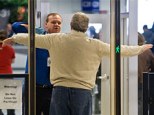 Shannon, Ireland – An ocean away from the United States, travelers flying out of the international airport here on the west coast of Ireland are confronting one of the newest lines of defense in the war on terrorism: the United States border.
Shannon, Ireland – An ocean away from the United States, travelers flying out of the international airport here on the west coast of Ireland are confronting one of the newest lines of defense in the war on terrorism: the United States border.
In a section of this airport carved out for the Department of Homeland Security, passengers are screened for explosives and cleared to enter the United States by American customs and border protection officers before boarding. When they land, the passengers walk straight off the plane into the terminal without going through border checks.
At other foreign airports, including those in Madrid, Panama City and Tokyo, American officers advise the local authorities. American programs in other cities expedite travel for passengers regarded as low-risk.
The programs reflect the Obama administration’s ambitious effort to tighten security in the face of repeated attempts by Al Qaeda and other terrorists to blow up planes headed to the United States from foreign airports.
The thinking is simple: By placing officers in foreign countries and effectively pushing the United States border thousands of miles beyond the country’s shores, Americans have more control over screening and security. And it is far better to sort out who is on a flight before it takes off than after a catastrophe occurs.
“It’s a really big deal – it would be like us saying you can have foreign law enforcement operating in a U.S. facility with all the privileges given to law enforcement, but we are going to do it on your territory and on our rules,” the secretary of the Department of Homeland Security, Janet Napolitano, said on a flight back to the United States from the Middle East, where she negotiated with leaders in Israel and Jordan about joint airport security programs. “So you flip it around, and you realize it is a big deal for a country to agree to that. It is also an expensive proposition.”
Airports in 14 countries are participating in the programs, which have been expanded over the last several years and have required substantial concessions from foreign leaders. In many cases they have agreed to allow American officers to be placed in the heart of their airports and to give them the authority to carry weapons, detain passengers and pull them off flights.
Last December, the government of Abu Dhabi signed a letter of intent to build a terminal where American officers will clear passengers to enter the United States, the most ambitious agreement the United States has struck so far with an Arab country. On her recent trip to Jordan, Ms. Napolitano began negotiations with the ruling family there about similar efforts.
Peter T. King, the New York Republican who is chairman of the House Committee on Homeland Security, endorsed the overseas security efforts and said he hoped the department would expand them. “A lot of these attempts are coming from the Middle East,” he said, referring to terrorism plots, “and that drives home that we have an immediate problem and that we need to push for these programs there as hard as we can.”
The Obama administration sped up expansion of the programs, which cost about $115 million a year, after an Al Qaeda operative tried to detonate explosives hidden in his underwear on a flight from Amsterdam to Detroit on Christmas Day in 2009. The security at foreign airports drew fresh public attention last month after new reports that intelligence agencies thwarted another plot by Al Qaeda to detonate an underwear bomb on an American-bound airliner. After that news emerged, Ms. Napolitano said the new measures being put in place in foreign airports for flights to the United States would have stopped a terrorist from boarding a plane with such a bomb.
But critics of the department on Capitol Hill – particularly two Republican committee chairmen in the House, Darrell Issa of California and John L. Mica of Florida – questioned her claims and said that security in foreign airports is not robust enough.
Ms. Napolitano and other Obama administration officials praise the programs as essential to help protect the 80 million passengers a year who fly to the United States from 300 foreign airports, and a boon for travelers, who save time after landing,
Still, as with many other counterterrorism measures, it is hard to gauge the programs’ success or their impact on Al Qaeda and other terrorists. They have not foiled any major plots so far, and it is hard to imagine terrorists unaware of which airports had a robust American security presence and which were more vulnerable.
Homeland Security officials acknowledge that the United States cannot control security in every airport in the world. The focus, they said, was on expanding an American presence at airports with a significant number of United States-bound flights.
The officials said that of the roughly 30 million travelers who passed through foreign airports with American customs and border protection officers over the past two years, about 500 were deemed national security risks and were turned away or pulled aside for further questioning. Over the same period, about 18,000 air travelers were denied admission to the United States for reasons like having a criminal record or lacking a proper visa.
At Shannon, where American officers have checked passports since 1986, passengers bound for the United States first pass through the Irish government’s airport security and then through three levels of American security: One to check for explosives in shoes and carry-on luggage, then to get clearance to enter the United States, and finally to ensure that checked baggage does not contain contraband.
The biggest problem for the United States is that it cannot compel foreign governments to strengthen security at their airports. But the United States limits flights from foreign airports that do not meet minimum security standards and screen passengers using procedures modeled after those of the Transportation Security Administration.
American officers at foreign airports constitute the next level of security, and the “gold standard” is an arrangement like the one at Shannon, with comprehensive preboarding clearance.
There are still hundreds of airports where American officials have far less say. According to a Government Accountability Office report released last October, the T.S.A. “has identified serious or egregious noncompliance issues at a number of other foreign airports.”
Department officials, however, said in interviews that they were confident in the security at foreign airports because even those that do not have pre-clearance or American advisers are subject to audits by the T.S.A.
“There was an airport that a U.S. flight carrier wanted to use as a last point of departure two years ago, and we denied it because we couldn’t ensure that planes couldn’t be hit by a shoulder fired missile near the airport,” Ms. Napolitano said.
{NY Times/Matzav.com Newscenter}












El Al has been doing this for years. That’s probably where the idea is from.
This has been done for many years at the airports in Toronto and Montreal. In addition to increasing security, it is a huge boon for travelers because you don’t have to go through customs and immigration once you land in the US. That is how La Guardia Airport, which is not a port of entry to the US, can have international flights to Canada. I will be flying to Toronto from La Guardia next month.
???? ???, Welcome to Toronto!
“El Al has been doing this for years. Thats probably where the idea is from.”
+1